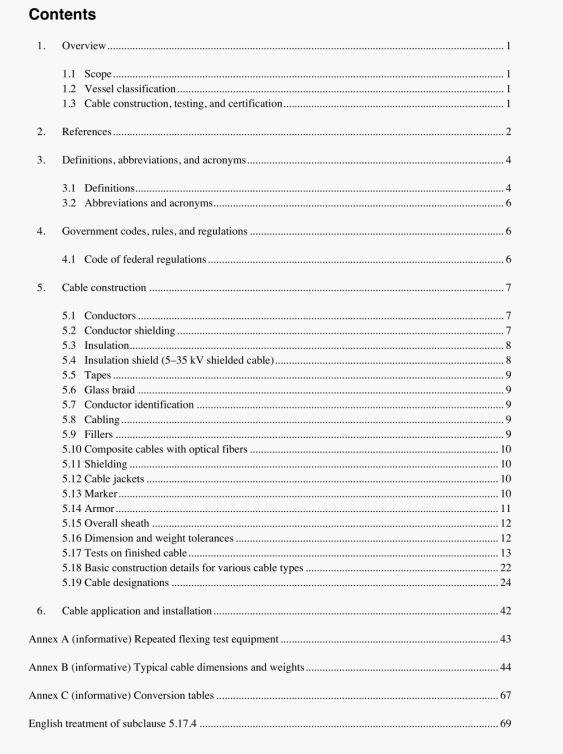IEEE 1580:2001 pdf free download.IEEE Recommended Practice for Marine Cable for Use on Shipboard and Fixed or Floating Platforms.
5.17.14 Incidental motion test
(Repeated flexing as listed in Title 46 CFR, subchapter J. subclause 111.60-23 and defined in Clause 3 of this recommended practice.)
Cable that is armored with continuously corrugated metal for use in areas of repealed flexing. on fixed or floating platforms, should pass this test. The apparatus (see Annex A) is comprised of a rocker assembly mechanism and a cable support fixture. The rocker mechanism is two vertical stanchions 2 m apart on a common base. Each stanchion is fitted with a set of rollers that provide a cradle configuration to support the wheels that carry the cable support fixture. The cable support fixture is a suitable metallic conduit 2.25 m long with Iwo 20-cm long windows cutting away approximately one-half the diameter of the conduit. The far ends of the windows arc 2 m apart and are equidistant from the midpoint of the conduit. The windows align in the same plane along the axis of the conduit.
The test sample is 2.75 m long, marked to identify 104 cm from the center on each side of the center. The cable sample is installed into the conduit through the windows. The 104 cm marks are aligned with the 2 m edges of the conduit to form a cacenary outside the conduit. The conduit section containing the cable is filled with a potting compound to encapsulate and anchor the cable sample in the conduit. The ends of the cable sample are exposed for voltage termination.
The sample IixtLlre is securely set in the rocker assembly with the axis of the support fixture conduit concentric to the axis of the rocker assembly so the catenaiy loop hangs vertically into the neutral position.
The drive is a gear-motor with a crank and connecting rod that rotates the sample along the horii’ontal axis. The drive mechanism provides motion to the rocker assembly plus and minus 30° from the vertical at 60 cycles per minute. A counter registers each total cycle.
The specimens are to be subjected to the dielectric withstand test described in 5.17.1 prior to starting the test to assure sample integrity. The results of the dielectric withstand test shall meet the requirements specified for those tests. The flexibility test will be run for a total of 500 000 cycles with the dielectric test in 5.17.1 performed after every 100 000 cycles. Any failure will result in conclusion of the testing. After 500 000 cycles, the sample shall meet the dielectric test in 5.17,l.The sample will then be dissected. If any deterioration (cracking or splitting) is found in any of the cable components. the cable fails the test.
IEEE 1580:2001 pdf free download
